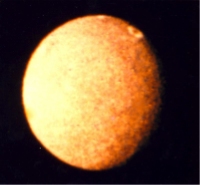
Uranus the third of the giant gas planets, is also the third largest planet and seventh planet from the Sun. Like Jupiter and Saturn it does not have a solid surface and is covered by thick cloud. It was the first major planet to be discovered - that is to say, it was not known to the ancient astronomers. In good viewing conditions, Uranus is just barely visible to the naked eye. Probably it had been mistaken for a star until 1781, when William Herschel reported its discovery as a planet.
Uranus is so far away that it cannot be observed in any detail from Earth. It was not until Voyager 2 flew past it in 1986 that we learned what it is really like. We now know that Uranus is mainly made of hydrogen and helium, with thick methane clouds surrounding it. The methane absorbs the red out of the sunlight and makes Uranus look blue-green. There has been no evidence of an internal heat source (unlike the other gaseous planets), and Uranus' distance from the Sun makes it a very cold planet.
In 1977, the ring system of Uranus was discovered by an indirect technique called "stellar occultation". In conjunction with NASA'S airborne observatory, Perth Observatory astronomers detected the rings when Uranus passed in front of a faint star. The star seemed to wink off and on as Uranus' rings interrupted the beam of starlight that was being monitored by the observers' instruments. No actual picture of the planet and the rings was obtained; that had to wait until Voyager 2's flyby in 1986. The rings are very narrow and are at radii of between 39 000 km and 51 000 km. The 15 known moons are outside of the ring system, the furthest being Oberon at 583 000 km radius.
Uranus is very different from the other planets in that it lies nearly on its side; the planet's axis is tilted 98 degrees from the orbital plane instead of being nearly upright like the other planets (Earth is tilted at 23.5 degrees). This means that if you could live hear one of the poles of Uranus, the Sun would be visible for 42 years, and then you would be in darkness for the next 42 years of the Uranian orbit around the Sun.
Physical Data
Uranus diameter: 51 118
km
Distance from Earth: 2 721 million km
Distance from Sun: 2,870 million km
Period of rotation: 17hr 14min
Period of orbit: 84 years
Number of moons: 15 (+ a ring system)